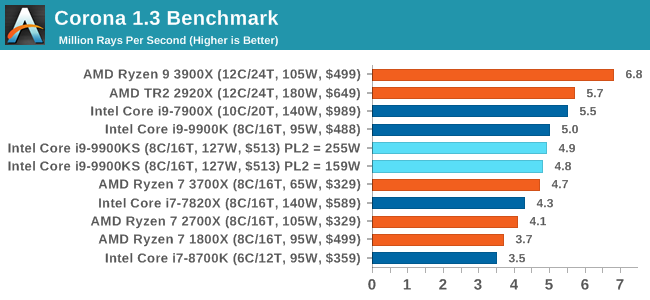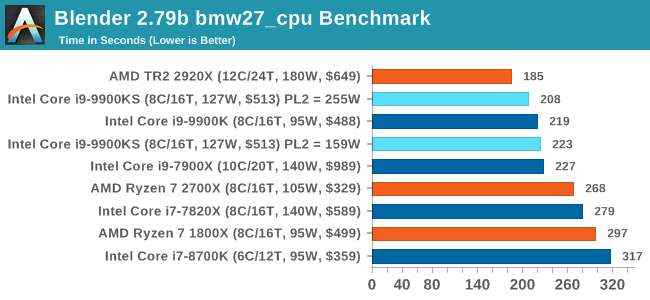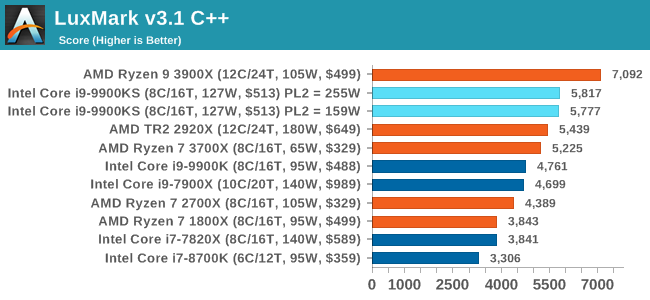The Intel Core i9-9900KS Review: The 5 GHz Consumer Special
by Dr. Ian Cutress on October 31, 2019 10:45 AM ESTCPU Performance: Rendering Tests
Rendering is often a key target for processor workloads, lending itself to a professional environment. It comes in different formats as well, from 3D rendering through rasterization, such as games, or by ray tracing, and invokes the ability of the software to manage meshes, textures, collisions, aliasing, physics (in animations), and discarding unnecessary work. Most renderers offer CPU code paths, while a few use GPUs and select environments use FPGAs or dedicated ASICs. For big studios however, CPUs are still the hardware of choice.
All of our benchmark results can also be found in our benchmark engine, Bench.
Corona 1.3: Performance Render
An advanced performance based renderer for software such as 3ds Max and Cinema 4D, the Corona benchmark renders a generated scene as a standard under its 1.3 software version. Normally the GUI implementation of the benchmark shows the scene being built, and allows the user to upload the result as a ‘time to complete’.
We got in contact with the developer who gave us a command line version of the benchmark that does a direct output of results. Rather than reporting time, we report the average number of rays per second across six runs, as the performance scaling of a result per unit time is typically visually easier to understand.
The Corona benchmark website can be found at https://corona-renderer.com/benchmark

Interestingly both 9900KS settings performed slightly worse than the 9900K here, which you wouldn't expect given the all-core turbo being higher. It would appear that there is something else the bottleneck in this test.
Blender 2.79b: 3D Creation Suite
A high profile rendering tool, Blender is open-source allowing for massive amounts of configurability, and is used by a number of high-profile animation studios worldwide. The organization recently released a Blender benchmark package, a couple of weeks after we had narrowed our Blender test for our new suite, however their test can take over an hour. For our results, we run one of the sub-tests in that suite through the command line - a standard ‘bmw27’ scene in CPU only mode, and measure the time to complete the render.
Blender can be downloaded at https://www.blender.org/download/

All the 9900 parts and settings perform roughly the same with one another, however the PL2 255W setting on the 9900KS does allow it to get a small ~5% advantage over the standard 9900K.
LuxMark v3.1: LuxRender via Different Code Paths
As stated at the top, there are many different ways to process rendering data: CPU, GPU, Accelerator, and others. On top of that, there are many frameworks and APIs in which to program, depending on how the software will be used. LuxMark, a benchmark developed using the LuxRender engine, offers several different scenes and APIs.
In our test, we run the simple ‘Ball’ scene on both the C++ and OpenCL code paths, but in CPU mode. This scene starts with a rough render and slowly improves the quality over two minutes, giving a final result in what is essentially an average ‘kilorays per second’.

Both 9900KS settings perform equally well here, and a sizeable jump over the standard 9900K.
POV-Ray 3.7.1: Ray Tracing
The Persistence of Vision ray tracing engine is another well-known benchmarking tool, which was in a state of relative hibernation until AMD released its Zen processors, to which suddenly both Intel and AMD were submitting code to the main branch of the open source project. For our test, we use the built-in benchmark for all-cores, called from the command line.
POV-Ray can be downloaded from http://www.povray.org/

One of the biggest differences between the two power settings is in POV-Ray, with a marked frequency difference. In fact, the 159W setting on the 9900KS puts it below our standard settings for the 9900K, which likely had an big default turbo budget on the board it was on at the time.











235 Comments
View All Comments
imaheadcase - Thursday, October 31, 2019 - link
So he makes a point about why people want a CPU and he is instant fanboy? Well you certainly got the boy part down pat..Jorgp2 - Thursday, October 31, 2019 - link
What are you talking about?Zen 2 only has a tiny IPC advantage over Skylake.
Spunjji - Friday, November 1, 2019 - link
10% isn't tiny, especially when boosting clock speeds by 10% is no longer trivial.Korguz - Friday, November 1, 2019 - link
imagine what it would be like if the clock speeds were higher... if zen 2 is this close, or faster with the clockspeed disadvantage it has now.. what will it be like if zen 2 was hitting 4.6+ ghz ???outsideloop - Friday, November 1, 2019 - link
We have a few months until Zen 3 clocks will leak.MDD1963 - Thursday, November 7, 2019 - link
Don't a full 10% of the 3900X samples actually have a core or two hit their advertised 4600 MHz for about 5 full consecutive seconds....sometimes? :)Korguz - Friday, November 8, 2019 - link
dont intel cpus NEED the higher clocks in order to have the performance they get ? clock them at the ryzen equivilents.. and see how well they perform.. when will people realize clock speed isnt everything ??amnesia0287 - Friday, November 8, 2019 - link
What would it be like if it hit 6ghz?Does it matter since it can’t?
I am very eager to see Zen 3 tho. Regardless of all the fanboys. I feel like it’s very much a mixed bag to chose between intel and amd just cause of some of the instruction sets and #of threads used by various things.
But if even half of the stuff about Zen3 is true 2020 should be AMDs year as I don’t believe anything intel launches until 2021 is really gonna be competitive.
rocky12345 - Tuesday, November 5, 2019 - link
Zen 2 has more like 13%-15% IPC gain over released Intel CPU's right now at same clock speeds depending on work load. There was a video on Youtube where one of the bigger YT channels did a side by side of AMD Zen 2 CPU and Intel 9900K both @4GHz and I was surprised that the AMD chip was ahead in most everything by a fair amount.When it came to gaming though Intel had a slight lead in a few games that seemed to favor Intel. But there were also games that AMD got wins from a s well. This would explain why AMD with a CPU with same core count is now able to match Intel even though AMD has a lower clock speed and even come close or match in a lot of games. I am no fanboy for either camp I currently only own Intel based systems but would be more than willing to look at either camps hardware when I do my next set of upgrades. That is just how good things are now on either side ans with AMD finally back in the game and putting pressure on Intel prices are also now getting better on the Intel side of the street as well. It is a win for everyone when things like this start happening.
AshlayW - Friday, November 1, 2019 - link
Hey, it's a good thing the 3900X doesn't have slow cores then, does it :)Seriously, though. i3-9350KF exists, go buy that if you want clock speed :P